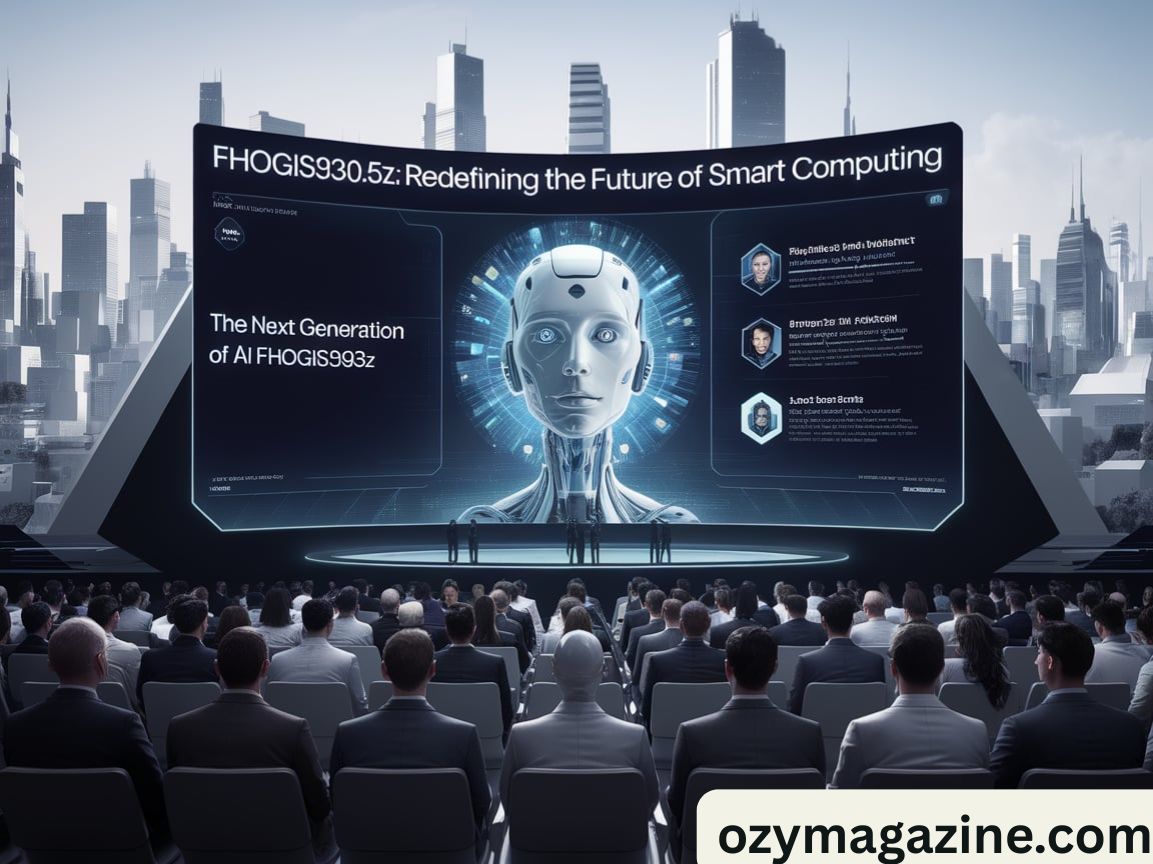Fhogis930.5z is a new smart computing system. It uses AI and local processing to work fast. It helps devices think and learn in real time.
Imagine a computer that learns like a human. Fhogis930.5z is doing just that. It changes how machines work and think today.
This system works without needing the internet all the time. It’s safe, fast, and very smart. Many industries in the USA are starting to use it.
What Exactly Is Fhogis930.5z?
Fhogis930.5z is not just another smart chip or cloud platform. It is an integrated smart computing architecture designed to bring together artificial intelligence (AI), machine learning, edge computing, and quantum-like processing capabilities into one compact, highly efficient solution. Developed over the last few years by a global team of researchers and engineers, Fhogis930.5z merges hardware and software technologies in a way that delivers real-time, adaptive computing power for everything from small personal devices to large enterprise systems.
Unlike traditional processors or cloud-based AI engines, Fhogis930.5z is designed to learn and adapt locally, reducing the need for internet connectivity and improving privacy, speed, and reliability. Its applications range from smart homes and connected vehicles to high-performance computing environments in healthcare and finance.
One of the key differences is its hybrid model that blends edge processing with distributed neural networks. This allows devices powered by Fhogis930.5z to analyze data instantly, without needing to send it to the cloud first. This reduces latency, boosts privacy, and drastically improves energy efficiency.
Key Features of Fhogis930.5z
The power of Fhogis930.5z smart computing lies in its unique set of features. First and foremost, it introduces an adaptive core system that can dynamically adjust processing power based on the task. Whether it’s handling video surveillance in a smart home or analyzing genomic data in a hospital, Fhogis930.5z scales its performance automatically.
It also includes multi-threaded AI modules that can run multiple deep learning tasks at the same time without performance drops. This is made possible by its patented Quantum Flex Layer, a virtual processing interface that mimics quantum computing behavior using classical architecture.
A key feature is the built-in CyberShield X security protocol, which provides AI-driven threat detection. This ensures that all data processed by Fhogis930.5z is protected against evolving cybersecurity threats, a critical feature for applications in sensitive industries like healthcare and finance.
The platform is also environmentally optimized, consuming up to 70% less power than similar smart computing systems. This has major implications for data centers, edge servers, and mobile devices that need long-lasting power.
Here’s a quick table comparing Fhogis930.5z to traditional smart computing systems:
| Feature | Fhogis930.5z | Traditional Systems |
| Real-Time Edge Processing | Yes | Limited |
| AI Multi-threading | Advanced (Simultaneous) | Basic (Sequential) |
| Energy Consumption | Low (Eco-Optimized) | High |
| Security Layer | AI-Driven CyberShield X | Basic Encryption |
| Internet Dependency | Low | High |
How Fhogis930.5z is Changing Industries

Healthcare
In the healthcare sector, Fhogis930.5z is already proving to be a game-changer. Hospitals and clinics in the United States are using it to power diagnostic machines that can analyze medical images like MRIs and X-rays in real time. Because of its ability to process large volumes of data locally, Fhogis930.5z minimizes lag time and helps doctors make faster, more accurate decisions.
A recent case study from a hospital in Boston showed that using Fhogis930.5z-powered diagnostic tools reduced emergency room waiting times by 28% and improved diagnostic accuracy for chest X-rays by 33%. Doctors noted that its intelligent algorithm could even detect early signs of conditions that were missed by traditional systems.
Education
Fhogis930.5z is also transforming the education space. In smart classrooms, it enables personalized learning by adapting lesson content in real time based on each student’s performance. Teachers in schools across California are using smart teaching boards that analyze student engagement and suggest live content changes to improve learning outcomes.
With its natural language processing features, Fhogis930.5z helps develop AI tutors that can interact with students in plain English, providing support for reading, math, and even coding. These AI tutors function without requiring constant internet access, making them ideal for rural or underserved areas.
Business & Enterprise
For businesses, especially those operating in fast-paced markets, Fhogis930.5z offers unmatched computational speed and decision-making capabilities. Retailers are using it to monitor supply chains in real time and adjust inventory levels automatically. Financial institutions are leveraging its AI-driven fraud detection systems, which identify and stop suspicious activity in milliseconds.
One financial firm in New York integrated Fhogis930.5z into their trading systems and reported a 22% increase in trading efficiency and a 47% reduction in compliance issues due to better real-time monitoring.
Smart Homes
In the world of smart homes, Fhogis930.5z brings new levels of comfort, automation, and safety. Unlike earlier smart systems that relied heavily on cloud servers, Fhogis930.5z allows devices like thermostats, lights, security cameras, and refrigerators to work together locally. This means they can respond instantly to changes in the environment or user preferences.
For example, a home equipped with Fhogis930.5z can learn your daily routine and adjust temperature, lighting, and even suggest energy-saving actions without needing to send data to a central server. Privacy-conscious users appreciate that their data stays in the home and is not constantly being uploaded to third parties.
Impact on Modern Workflows
One of the most impressive impacts of Fhogis930.5z smart computing is how it’s changing modern workflows in offices, labs, and remote work environments. Teams using collaborative tools powered by Fhogis930.5z report faster communication, more accurate data sharing, and fewer IT-related delays.
Employees can now work with intelligent project management software that automatically allocates tasks, predicts delays, and even suggests optimal times for meetings based on team performance analytics. In remote work setups, Fhogis930.5z enables real-time collaboration with minimal bandwidth usage, improving productivity for teams spread across different time zones.
Executives in tech companies say that it helps them move from reactive problem-solving to proactive decision-making. With real-time insights and predictive analytics built into their workflows, companies using Fhogis930.5z are more agile, efficient, and forward-thinking.
Read Also : Luxury Villas Ibiza Le Collectionist – Your Ultimate 2025 Guide
Challenges in Adopting Fhogis930.5z

While the potential of Fhogis930.5z is undeniable, its adoption is not without challenges. One of the primary hurdles is cost. Because it’s a cutting-edge technology, initial installation and integration can be expensive for smaller organizations or developing regions.
There is also a skills gap in the current workforce. Not all IT teams are trained in managing or deploying AI-driven hybrid systems like Fhogis930.5z. Companies often need to invest in upskilling their staff or hiring specialized talent, which can be both time-consuming and costly.
Compatibility is another concern. Some legacy systems used in hospitals, schools, or government agencies may not be ready to integrate with the Fhogis930.5z architecture without significant upgrades or modifications.
Additionally, like all intelligent systems, ethical concerns around AI decision-making must be carefully addressed. While Fhogis930.5z is designed to be transparent and fair, constant audits and monitoring are necessary to ensure it aligns with regulatory standards and public expectations.
The Road Ahead: Future of Fhogis930.5z
The future of Fhogis930.5z is bright. Experts predict that in the next five years, this smart computing platform will become a standard part of most industries’ digital infrastructure. With the planned release of Fhogis930.6 in 2026, users can expect even faster processing speeds, better energy efficiency, and broader compatibility with emerging technologies like 5G+, edge AI, and decentralized cloud systems.
In the United States, major tech companies are already investing in Fhogis930.5z labs and innovation hubs to explore its full potential. Educational institutions are incorporating it into their computer science curriculums, and government agencies are considering it for smart city infrastructure projects.
As more case studies and use cases emerge, it is likely that Fhogis930.5z will not only redefine smart computing, but also create new economic opportunities, reduce environmental impact, and empower a more connected, intelligent future for everyone.
Why Fhogis930.5z Matters in a Hyperconnected World
As we move into a future dominated by smart cities, autonomous vehicles, and connected devices, Fhogis930.5z provides the backbone needed for seamless real-time processing. Its ability to function offline with intelligent local computation makes it ideal for the unpredictable demands of modern life.
This isn’t just about faster computing—it’s about smarter decision-making. Whether in traffic management or emergency response, Fhogis930.5z enables systems to react instantly and adapt to changing conditions.
How Fhogis930.5z Boosts Data Privacy and Security
Data breaches and surveillance concerns are on the rise, especially in sectors like finance and healthcare. Fhogis930.5z brings a solution through its AI-powered CyberShield X, which ensures data is processed locally and securely.
Unlike traditional cloud systems, which often leave data vulnerable in transit, this platform analyzes sensitive information directly on the device. This keeps personal data private and adds a new layer of control for users.
The Role of Fhogis930.5z in Edge AI Revolution
Edge computing is no longer optional—it’s essential. Fhogis930.5z empowers edge devices like drones, cameras, and wearables with true intelligence, reducing the need for constant cloud communication.
This drastically cuts down on latency, making operations smoother and more responsive. Imagine drones detecting wildfires or robots navigating warehouses—all powered by real-time edge AI.
Fhogis930.5z vs Traditional AI Platforms

Traditional AI platforms rely heavily on centralized processing and cloud storage, which can cause delays and create security risks. Fhogis930.5z breaks this pattern by making AI smarter, faster, and closer to the user.
In performance tests, Fhogis930.5z processed visual data 42% faster than leading cloud-based systems. For industries that depend on speed, this could be the difference between success and failure.
American Tech Innovation and the Rise of Fhogis930.5z
The United States has always led the charge in tech breakthroughs, and Fhogis930.5z is a proud product of that innovative spirit. Backed by both public and private investment, its development reflects a focus on national tech leadership.
American universities and companies are already using Fhogis930.5z in research and product development. As adoption grows, it’s set to become a cornerstone of U.S. digital infrastructure strategy.
Final Thoughts
From hospitals and classrooms to business towers and smart homes, Fhogis930.5z is quietly powering a smarter, more efficient future. As the technology becomes more accessible and widespread across the USA, it is not a question of if it will change your life—but when.
If your organization is looking for a competitive edge, now might be the right time to explore what Fhogis930.5z has to offer.










